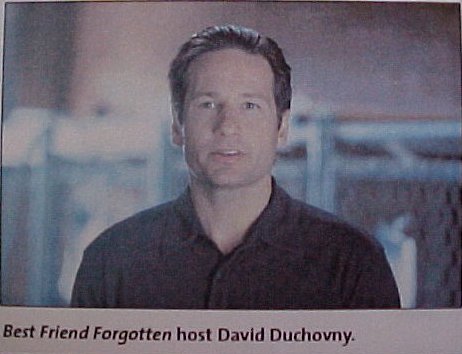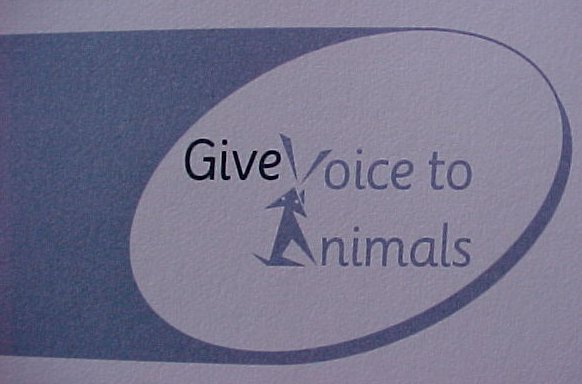Monday, February 16, 2004
Locations and times TBD



A new documentary, “Best Friend Forgotten", with voiceover by David Duchovny,
airing on PBS Outreach programs, presents effective messages about pet-owner
responsibility, spay/neuter, and adoption.
To be a volunteer in the effort to broadcast this film as widely as possible,
please visit
http://www.givevoicetoanimals . . .
FOLLOWING IS A GREAT REVIEW, and contains well-worded, factual information you
might want to copy and pass on.
Thanks, all!
Your List Owner,
Cynthia
THE REVIEW:
The opening moments of “Best Friend Forgotten" starkly demonstrate just
how much the public is in need of a movie like this one. When asked, “Do
you know what pet overpopulation is?” several people interviewed on the
street react as if they’re hearing a foreign language.
But with its focus on two individual shelter animals, use of effective
statistics, and emphasis on key themes related to animal homelessness,
this compelling film will serve as a solid education for many people
unfamiliar with the work of shelters and animal care and control
agencies.
"Best Friend Forgotten", produced and directed by Julie Lofton and filmed
over two years, paints a bleak picture. But the film also provides hope, in
the form of information about spaying and neutering and adoption.
Viewers of the documentary hear from animal control officers, shelter
employees, veterinarians, rescue group volunteers, a senator, and others
as the film illustrates the consequences of pet overpopulation.
Through the voiceover by actor David Duchovny, viewers learn of the
millions of “unwanted” animals with uncertain futures. Early in the film,
Maddie’s fund president Rich Avanzino says, “We are failing our best
friends.”--– a theme that’s echoed in later parts of the movie. In segments
interspersed throughout the film, Duchovny narrates the stories of two of
these homeless friends – Oreo, an abandoned black-and-white cat found
near a tenement building and brought to Chicago Animal Care and
Control, and Clover, a stray Lab mix picked up by Los Angeles City
Animal Services.
Choosing two animals to follow enables the filmmaker to put a furry face
on animal homelessness. In telling these tales, Best Friend Forgotten
touches on mobile adoption events, the fate of stray dogs and cats, and
the consequences of a minor illness on a newly admitted shelter resident.
The narrative is instructive, but it is the animals who speak louder than
any words could; Clover’s happy expression and newly shiny black coat,
seen at the conclusion of his story, seem to say it best.
Accompanying the stories are hard statistics that provide yet another
effective means of education. With carefully placed numbers, the film
illustrates the seriousness of the pet overpopulation problem. Appealing
to viewers’ bank accounts, Senator Dick Durbin of Illinois reveals that the
current situation has been estimated to cost tax payers two billion dollars
per year. Later he informs viewers that 10,000 babies are born each day,
while an incredible 70,000 puppies and kittens enter the world every 24
hours. Duchovny demonstrates the need for improvement in shelter
adoptions by stating that fewer than 20 percent of pet owners adopt from
shelters.
Numbers continually speak for themselves – Melanie Sobel, program
director at the Chicago shelter, tells the audience that while the agency
takes in approximately 30,000 animals each year, only 3,000 are
adopted. Thousands of animals make their temporary home at the L.A.
shelters; only a scant few can be taken to filmed mobile pet adoption
events.
Best Friend Forgotten ventures beyond numbers to get its important
messages across. The viewer is repeatedly reminded of the high numbers
of animals without homes; too many even for the thousands of animal
shelters in the country to handle. The audience will find it difficult to
ignore the fact that caring for them is an enormous task – and that
shelters cannot possibly house and handle every animal who comes
through their doors.
The film also emphasizes that people are the root of the problem. Sobel
points out that although many reasons are provided by people who
relinquish pets, the “real reason” is often that they weren’t aware of the
difficulty and responsibility involved in keeping a pet. Along with a
discussion about stray and feral cats, Duchovny offers the sobering
statistic that five out of ten dogs will change owners before they’re even
a year old.
"Best Friend Forgotten" also shows that many people are simply
uneducated about being responsible pet owners, and that spay/neuter
programs need more vigorous outreach efforts. Several spay/neuter
“myths” are expressed by dog owners in this film and then summarily
debunked by a veterinarian.
Euthanasia features prominently, with the alternative presented as a bleak
existence: “life in a cage without love and attention from a real family.”
Because of a scarcity of resources and space, viewers are told, it is
impossible for shelters to care for millions of animals. While not shown
on camera, euthanasia is suggested and briefly described, and the
audience sees a veterinarian checking for the heart beat of a cat
post-euthanasia. At some points, euthanasia is referred to as just that: at
others, “killed” is the term of choice.
The “no-kill” movement makes an appearance, presented as the
opposition to euthanasia. However, a quote from Best Friends Animal
Sanctuary’s Michael Mountain is juxtaposed with a statement showing
that municipal shelters simply take in more animals than “no kills” can.
(The film appears to give the impression that only municipal shelters can
be open-admission.) Duchovny boils down the debate when he reveals
that Best Friends houses 1,800 animals while the Chicago shelter takes in
30,000 new animals every year.
"Best Friend Forgotten" provides an excellent opportunity for the public to
learn about animal homelessness.
Give Voice to Animals is a 501 c3 tax exempt U.S. organization.